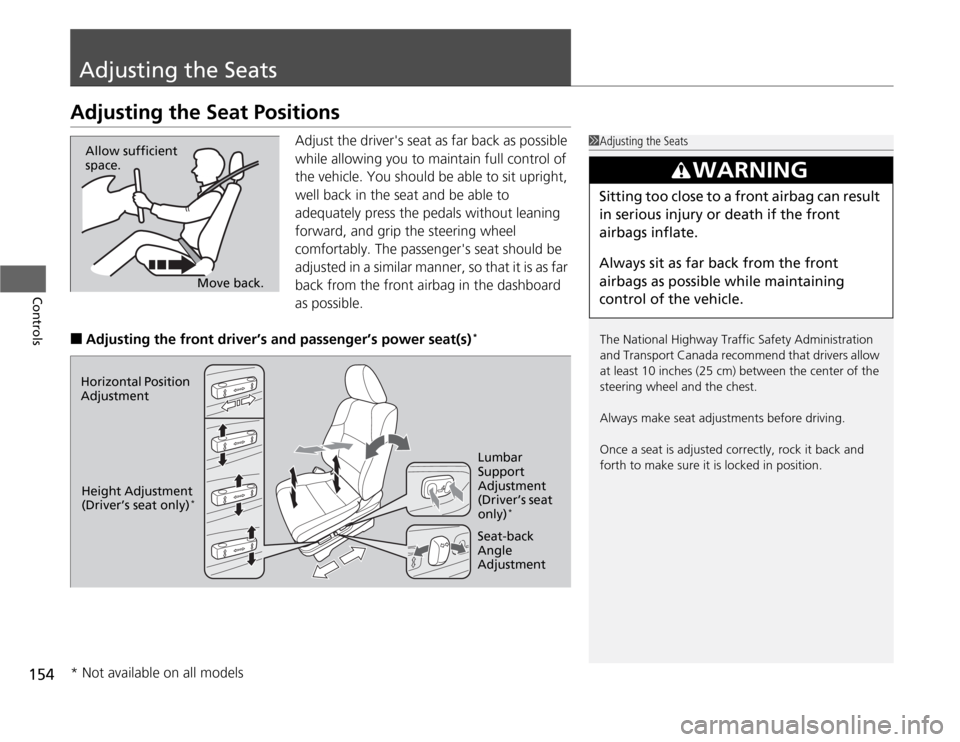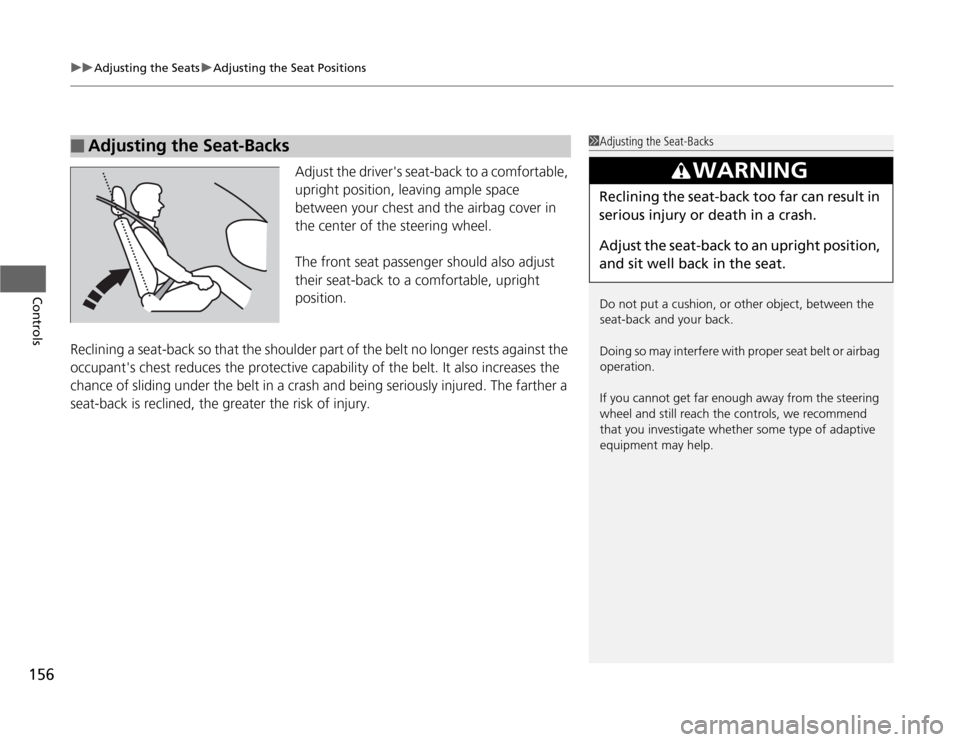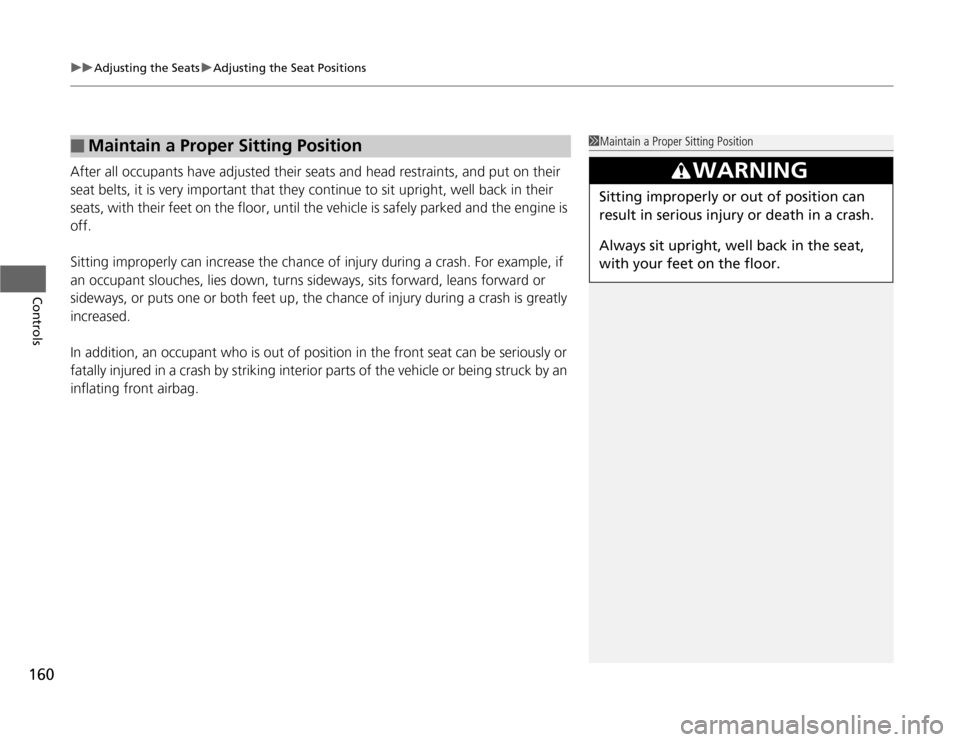Page 155 of 441

154Controls
Adjusting the SeatsAdjusting the Seat Positions
Adjust the driver's seat as far back as possible
while allowing you to maintain full control of
the vehicle. You should be able to sit upright,
well back in the seat and be able to
adequately press the pedals without leaning
forward, and grip the steering wheel
comfortably. The passenger's seat should be
adjusted in a similar manner, so that it is as far
back from the front airbag in the dashboard
as possible.
■
Adjusting the front driver’s and passenger’s power seat(s)
*
1Adjusting the Seats
The National Highway Traffic Safety Administration
and Transport Canada recommend that drivers allow
at least 10 inches (25 cm) between the center of the
steering wheel and the chest.
Always make seat adjustments before driving.
Once a seat is adjusted correctly, rock it back and
forth to make sure it is locked in position.
3
WARNING
Sitting too close to a front airbag can result
in serious injury or death if the front
airbags inflate.
Always sit as far back from the front
airbags as possible while maintaining
control of the vehicle.
Move back. Allow sufficient
space.
Horizontal Position
Adjustment
Height Adjustment
(Driver’s seat only)
*
Seat-back
Angle
AdjustmentLumbar
Support
Adjustment
(Driver’s seat
only)
*
* Not available on all models
Page 156 of 441
155
uuAdjusting the SeatsuAdjusting the Seat Positions
Continued
Controls
■
Adjusting the passenger’s manual seats
Seat-back Angle
AdjustmentPull up the lever to
change the angle.
Seat-back Angle
AdjustmentPull the strap to change
the angle.
Seat-back Angle
AdjustmentPull up strap on the
right to change the
angle of the right
halves of the seat-
back, and left for the
left halves.
The front
* and second row outer
The second row center seat
Horizontal Position
AdjustmentPull up the bar to move
the seat, then release
the bar.
The third row
* Not available on all models
Page 157 of 441

uuAdjusting the SeatsuAdjusting the Seat Positions
156Controls
Adjust the driver's seat-back to a comfortable,
upright position, leaving ample space
between your chest and the airbag cover in
the center of the steering wheel.
The front seat passenger should also adjust
their seat-back to a comfortable, upright
position.
Reclining a seat-back so that the shoulder part of the belt no longer rests against the
occupant's chest reduces the protective capability of the belt. It also increases the
chance of sliding under the belt in a crash and being seriously injured. The farther a
seat-back is reclined, the greater the risk of injury.
■
Adjusting the Seat-Backs
1Adjusting the Seat-Backs
Do not put a cushion, or other object, between the
seat-back and your back.
Doing so may interfere with proper seat belt or airbag
operation.
If you cannot get far enough away from the steering
wheel and still reach the controls, we recommend
that you investigate whether some type of adaptive
equipment may help.
3
WARNING
Reclining the seat-back too far can result in
serious injury or death in a crash.
Adjust the seat-back to an upright position,
and sit well back in the seat.
Page 159 of 441
158
uuAdjusting the SeatsuAdjusting the Seat Positions
Controls
■
Adjusting the front and second row outer and third row outer head
restraint positions
To raise the head restraint: Pull it upward.
To lower the head restraint: Push it down
while pressing the release button.
Page 161 of 441

uuAdjusting the SeatsuAdjusting the Seat Positions
160Controls
After all occupants have adjusted their seats and head restraints, and put on their
seat belts, it is very important that they continue to sit upright, well back in their
seats, with their feet on the floor, until the vehicle is safely parked and the engine is
off.
Sitting improperly can increase the chance of injury during a crash. For example, if
an occupant slouches, lies down, turns sideways, sits forward, leans forward or
sideways, or puts one or both feet up, the chance of injury during a crash is greatly
increased.
In addition, an occupant who is out of position in the front seat can be seriously or
fatally injured in a crash by striking interior parts of the vehicle or being struck by an
inflating front airbag.■
Maintain a Proper Sitting Position
1Maintain a Proper Sitting Position
3
WARNING
Sitting improperly or out of position can
result in serious injury or death in a crash.
Always sit upright, well back in the seat,
with your feet on the floor.
Page 162 of 441
161
uuAdjusting the SeatsuAdjusting the Seat Positions
Controls
The driver’s and front passenger’s seats have active head restraints. In a rear impact,
an occupant properly secured by a seat belt will be pushed against the seat-back and
the head restraint will move forward. This reduces the distance between the
restraint and the occupant’s head, which helps reduce the likelihood of whiplash
and injuries to the neck and upper spine.■
Active Head Restraints
1Active Head Restraints
In order for the active head restraints to operate
properly:•Do not hang any items on the head restraints, or
from the restraint legs.•Do not place any objects between an occupant and
the seat-back.•Install each restraint in its proper location.
After a collision, the activated restraint should return
to its normal position. If the restraint does not return
to its normal position, or in the event of a severe
collision, have the vehicle inspected by a dealer.
Page 164 of 441
Continued
163
uuAdjusting the SeatsuRear Seats
Controls
1.Lower the head restraint to its lowest
position.
2.Move the seat to it’s rear most position.
3.Fold the seat-back down.
4.Pull the lock release lever, and lift the rear
of the seat.
uTo lift the seat, grab the handle under
the rear side of the seat cushion.
5.Pull the seat-back slightly, then pivot it
upward.
uThis unhooks the front of the seat from
the floor.
■
Removing a Second Row Outer Seat
1Removing a Second Row Outer Seat
Do not remove the seat while driving.
To reinstall the seat, hook the front of the seat to the
floor first. Pushing the rear of the seat-back locks the
seat in place. Make sure the seat is latched before
driving.
Handle
Seat-back Angle
adjustment LeverLock Release Lever
Page 165 of 441
uuAdjusting the SeatsuRear Seats
164Controls
1.Lower the head restraint to its lowest
position.
2.Move the seat to it’s rear most position.
3.Fold the seat-back down.
4.Pull the lock release lever, and lift the rear
of the seat.
uTo lift the seat, grab the handle under
the rear side of the seat cushion.
5.With the front of the seat hooked to the
floor, slide the seat laterally to the outer
position until it stops.
6.Lower the seat and push the rear of the
seat-back until it locks. Make sure the seat
is latched before driving.
■
Sliding the Second Row Outer Seats Outward
1Sliding the Second Row Outer Seats Outward
When the second row outer seats are in the original
(center) position, passengers have easier access to the
third row seats. When they are in the outer position,
you can install two or three child seats in the second
row seats.
Handle
Slide